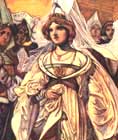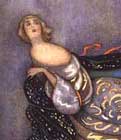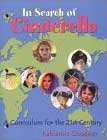
Cinderella:
345 Variants
by Marian
Roalfe Cox
SurLaLune's
Cinderella Area
SurLaLune Fairy Tales Main Page
277
Brauns, David, Japanische Märchen und Sagen. Leipzig, 1885. Pp. 74-8.
"THE GIRL WITH THE WOODEN BOWL."
ABSTRACT
Dying mother puts wooden bowl on daughter's head to hide her extreme beauty. Bids her never take it off. Heroine disguise--Menial Heroine--Master's son peeps beneath bowl; falls in love with heroine. She will not marry him. Mother-help in dream--Heroine now consents to marriage; but bowl cannot be removed--Happy marriage--At wedding-feast howl bursts and falls to the ground. The pieces are transformed to precious stones and rare jewels.
TABULATION
(1) Very many years ago there lived, in a little village in the province of Pamato, a couple who had hitherto seen good days. Misfortune befalls them; and not liking to live in poverty amongst former friends, they go to distant village. Here husband dies, leaving widow with extremely lovely daughter. Mother fears her beauty may be 5ource of danger to her, and instructs her in all virtue and diligence. Years pass, and mother feeling rid approaching, calls daughter to bedside, and bids her fetch little wooden bowl. Daughter gives it her, and kneels down beside bed, when mother turns wooden bowl over her head. 11cr face is thus quite shadowed, and no one would suspect how much beauty the bowl conceals. Mother is comforted, and after exhorting daughter never to leave bowl far from her head, dies in peace.-- (2) Heroine goes forth to earn living by working in the fields, always wearing the wooden howl. She gets called Hatschibime", that is, the maid with the bowl. Many youths try to persuade her to take off hat, but she always refuses. She earns a spare livelihood in this way, till one day the richest land-owner in the neighbourhood noticing her exceptional industry, engages her to be nurse to his sick wife, and she spends happier days.-- (3) Her master's eldest son has just retuned home from studying in Kioto, the splendid residence of the Mikado. He notices heroine, and laughs at her whim never to remove wooden bowl. One day he peeps beneath it without her noticing, sees her great beauty, and falls in love with her.-- (4) He is anxious to marry her, but his parents and friends object, and his mother and aunt try to calumniate the good girl. But he heeds them not, and soon proves their statements untrue. He persists in his intention to marry her, and informs all his relatives. Quite unexpectedly the girl herself makes difficulties. She thinks it wrong to change her hard but safe lot for an idle life of ease, against the wish of her protector. She is indeed in love with the son, and weeps bitterly, though holding fast to her resolve.-- (5) At night her mother appears to her in a dream, and bids her wed the young man. The next time she is asked to marry him, she gladly consents.-- (6) The wedding-day is fixed. He has to bear with much mockery, but cares not, being happy over his good fortune. On the wedding-day the bride at last consents to take off wooden bowl, but it will not leave her head, and she screams with pain on trying to remove it. Marriage is celebrated with bowl on her head.-- (7) Afterwards it feast, when wine is brought, as she empties the cup the wooden bowl bursts with a loud noise, and falls in pieces to the ground. When they come to examine these pieces they find rare stones and precious jewels hidden under them. But the bride's beauty excites still greater admiration, The pair live happily together, and have many children, all beautiful and good like their mother.
Cox, Marian Roalfe. Cinderella: Three Hundred and Forty-five Variants of Cinderella, Catskin, and Cap O' Rushes, abstracted and tabulated. London: David Nutt for the Folklore Society, 1893.
While the original text of this book is out of copyright, the special formatting and compilation available on SurLaLune Fairy Tales is copyrighted. Be aware that while the original content has been honored, page numbering, footnote numbering, redesigned charts, links, and other aspects are unique to this site's version of the text. Use at your own risk. For private and fair use educational purposes only.
©Heidi
Anne Heiner, SurLaLune Fairy Tales
E-mail: surlalune@aol.com
Page last updated February 1, 2006
www.surlalunefairytales.com










